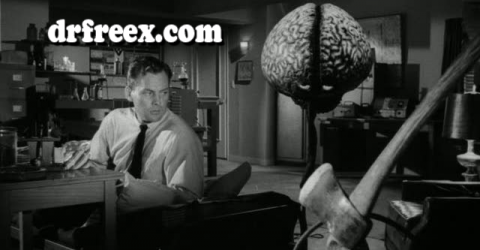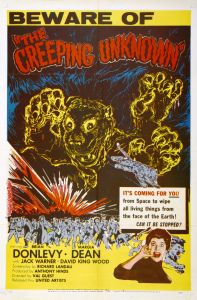 I said I was going to ride this Quatermass train as long as I could, and seeing as how this one is called The Quatermass Conclusion, it’s looks like I may have to actually put some effort into finding an entry for Q next year.
I said I was going to ride this Quatermass train as long as I could, and seeing as how this one is called The Quatermass Conclusion, it’s looks like I may have to actually put some effort into finding an entry for Q next year.
In the intervening years since Quatermass and the Pit, the British Rocket Program has shut down, and Bernard Quatermass (John Mills, this time) has retired. He journeys from his home in Scotland to London on a twofold mission: to appear as a guest on a talk show, and to look for his granddaughter, who ran away from Scotland in a fit of rebellious boredom. London, Quatermass finds, has gone right downhill; street gangs have turned the city into a combination of Mad Max and Clockwork Orange. He’s only saved from a savage beating by the arrival of radio astronomer Joe Kapp (Simon MacCorkindale) in his armored vehicle, complete with guard dog.
 The TV show is celebrating the linking of American and Soviet spacecraft in a precursor to the International Space Station. Quatermass’ bitter dismissal of it is rather undercut by the station’s sudden destruction, though. Quatermass accompanies Kapp to his home/radio telescope base to find some answers, only to discover another bit of weirdness in play: lines of young people trooping across the countryside, following leaders with plumb bobs and apparently walking along Ley Lines to rings of standing stones. These are “the Planet People”, claiming they are going to be taken to another world. One such gathering is obliterated by a colossal beam of energy from the sky. Quatermass and Kapp find a girl that was on the very edge of the blast area, burned and delirious. They carry her away to treat her wounds, much over the violent protestations of the Planet People who didn’t get reduced to ash (or “transported”, as they insist).
The TV show is celebrating the linking of American and Soviet spacecraft in a precursor to the International Space Station. Quatermass’ bitter dismissal of it is rather undercut by the station’s sudden destruction, though. Quatermass accompanies Kapp to his home/radio telescope base to find some answers, only to discover another bit of weirdness in play: lines of young people trooping across the countryside, following leaders with plumb bobs and apparently walking along Ley Lines to rings of standing stones. These are “the Planet People”, claiming they are going to be taken to another world. One such gathering is obliterated by a colossal beam of energy from the sky. Quatermass and Kapp find a girl that was on the very edge of the blast area, burned and delirious. They carry her away to treat her wounds, much over the violent protestations of the Planet People who didn’t get reduced to ash (or “transported”, as they insist).
 A visit from the local commissioner (Margaret Tyzack) causes Kapp to use his radio telescopes to bounce off some satellites to receive a video call from America, because there have been more energy beams, killing thousands, and they need to get Quatermass’ opinion (I do love the fact that, no matter how much crap Quatermass has been through, if something weird comes from space, he’s the go-to guy). Quatermass and the Commissioner manage to get the girl (who looks eerily like Yolandi Visser from Die Antwoord) to a hospital; her burned tissues are turning into crystal. Well, they are until she levitates and explodes, anyway.
A visit from the local commissioner (Margaret Tyzack) causes Kapp to use his radio telescopes to bounce off some satellites to receive a video call from America, because there have been more energy beams, killing thousands, and they need to get Quatermass’ opinion (I do love the fact that, no matter how much crap Quatermass has been through, if something weird comes from space, he’s the go-to guy). Quatermass and the Commissioner manage to get the girl (who looks eerily like Yolandi Visser from Die Antwoord) to a hospital; her burned tissues are turning into crystal. Well, they are until she levitates and explodes, anyway.
 Quatermass theorizes that something ahead of the energy beams – some advance waves, or similar – has been feeding into the youthful members of society, causing the upset of gang warfare, and the mass migrations to the ancient sites, standing stones erected by bygone societies as a warning. As the beams continue to rain down, he recruits a group of literally senior scientists, immune from the alien influence, to attempt to forge a solution before mankind is virtually exterminated.
Quatermass theorizes that something ahead of the energy beams – some advance waves, or similar – has been feeding into the youthful members of society, causing the upset of gang warfare, and the mass migrations to the ancient sites, standing stones erected by bygone societies as a warning. As the beams continue to rain down, he recruits a group of literally senior scientists, immune from the alien influence, to attempt to forge a solution before mankind is virtually exterminated.
Writer Nigel Kneale was approaching 60 at this time, and I’m amused that his cause for youthful sullenness and rebellion is alien intervention. It is no coincidence that Kneale fan John Carpenter took a similar tack in They Live: the only possible explanation for the callousness and cruelty of the Reagan Revolution was an alien invasion, right? People wouldn’t do that normally, right? Right?
 The budget on Conclusion is quite low, and the story somewhat drawn out at times – as traditional, this was a TV series first. Kneale wrote a separate script for the feature film version, but the seams are still somewhat apparent. Director Piers Haggard moves it all along quite amiably and well. The Quatermass Conclusion – simply Quatermass in its native land – is the most lo-fi of the Quatermass stories. There’s no giant monster shambling around, no conspiracies; the enemy and its motive is, as Quatermass concludes, ultimately unknowable, and the best humanity can manage is to bite them so hard they don’t come back – but at a terrible price. There’s a quite good BBC series called Invasion: Earth that owes a lot to Quatermass. That’s worth seeking out, too, if you haven’t had enough bleak science fiction pitting man against unimaginable forces.
The budget on Conclusion is quite low, and the story somewhat drawn out at times – as traditional, this was a TV series first. Kneale wrote a separate script for the feature film version, but the seams are still somewhat apparent. Director Piers Haggard moves it all along quite amiably and well. The Quatermass Conclusion – simply Quatermass in its native land – is the most lo-fi of the Quatermass stories. There’s no giant monster shambling around, no conspiracies; the enemy and its motive is, as Quatermass concludes, ultimately unknowable, and the best humanity can manage is to bite them so hard they don’t come back – but at a terrible price. There’s a quite good BBC series called Invasion: Earth that owes a lot to Quatermass. That’s worth seeking out, too, if you haven’t had enough bleak science fiction pitting man against unimaginable forces.


















